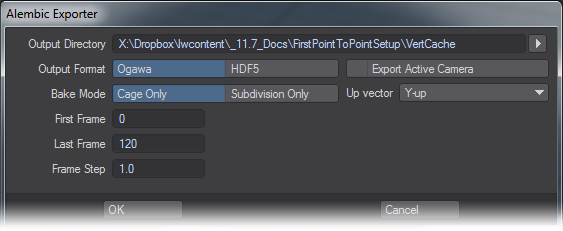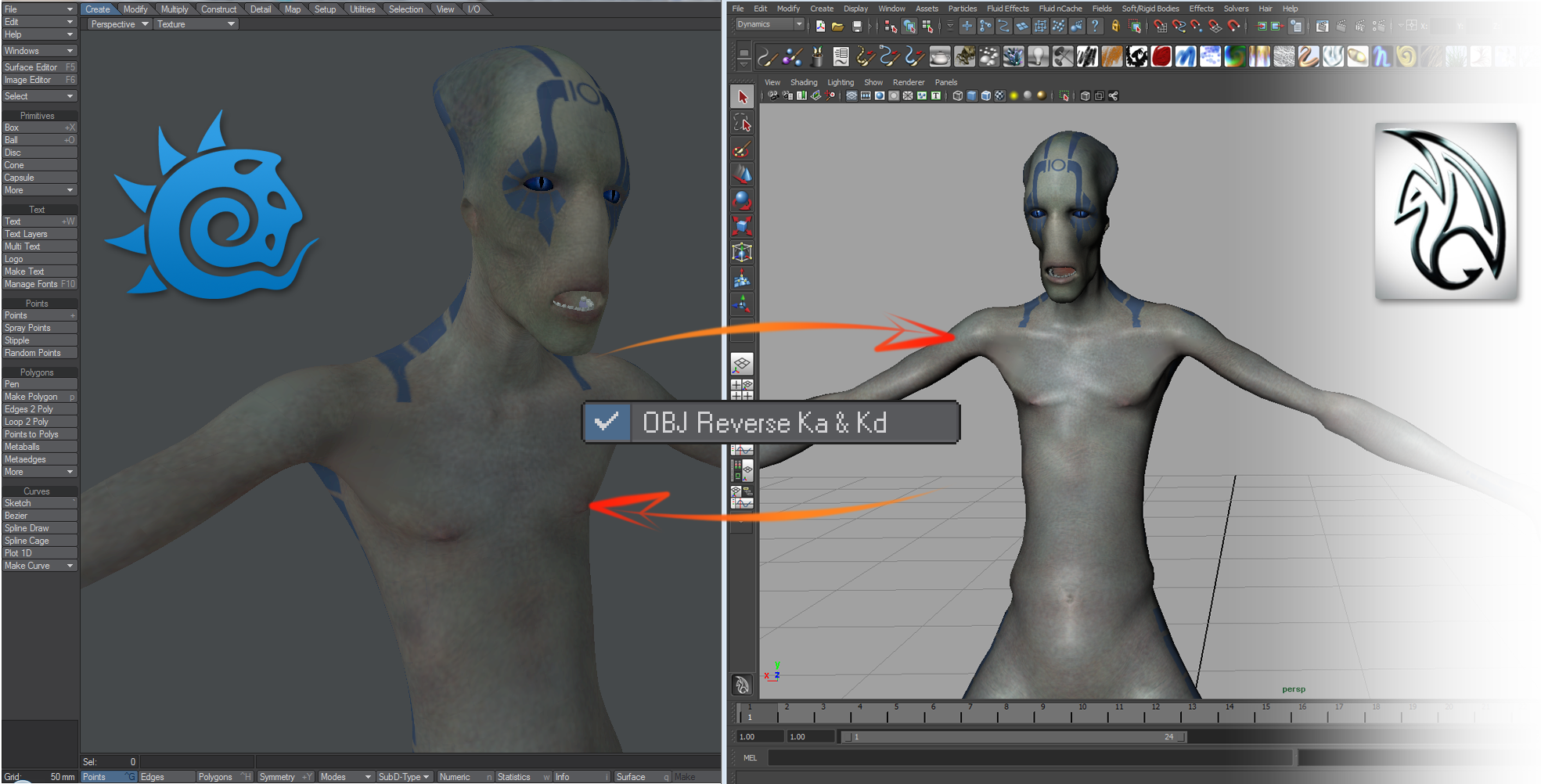Interchange
Collada Export Options
The exporter for Collada will save as a .dae file and offers the opportunity to scale the scene for use with other applications.
FBX Export Options
The exporter for FBX has different options, such as Binary or ASCII types, and allows you to save as different FBX versions.
- FBX Filename - This where you set the name of the FBX file and the location where it will be stored.
- Export - Choose whether you want to export the Models and Morphs (Blend Shapes) in the scene.
- Mesh Type - Cage (Subdivision Off) will export the object without any subdivision applied to it. Subdivision will apply subdivision to the mesh when it is exported.
- Re-parent bone hierarchy - when exporting a rig from Layout with the bone hierarchy parented to the mesh, the actual movement of the deformed mesh is double of what it should be. Checking Re-parent bone hierarchy creates a null which acts as the new parent of the bone hierarchy, keeping the mesh in place.
- Materials - LightWave’s standard Surface channels and image maps can be translated through FBX to appear correctly in a different application. Procedural textures and nodes cannot be translated.
- Embedded Textures - Embedded Textures are image maps included in the FBX file directly, rather than as a separate image directory. Embedding will create much larger FBX files, but self-contained.
- Smoothing Groups - Converts LightWave's normals into smoothing groups.
- Collapse Materials - This switch will collapse surfaces with identical names, but there are some rules:
- Material names match, and all surface parameters match - the two materials always get merged, independent of the export settings
- Only Material names match - materials are exported separately, except when the collapse material setting is switched on
- Merge UVs - Collapses multiple UV maps into a single map per object.
- Unity 3D Mode - See below.
- Cameras - Export a scene’s cameras in the FBX file.
- Lights - Export a scene’s lights in the FBX file.
- Animations - Simple animations based on movement, rotation or scaling can be exported without baking. Character animation or other animation using IK or dynamics should still be baked, using the next item.
- Bake Motion Envelopes - This will only be available if Animations is checked and allows you to set an arbitrary start and end point for baking, in case there are setup frames you do not wish to capture.
- Scale Scene - This setting will scale the scene based on the input entered.
FBX support is to version 2016 to support the most recent version of Autodesk’s MotionBuilder™ at time of writing.
Please note that Camera Export from Maya to LightWave is only pixel-perfect when baking the envelopes in Maya since curves are interpreted slightly differently between applications. A command has also been added so that you can script FBX export. The command Generic_ExportFBXCommand has the following arguments:
- <SceneFile>
- <Version>
- <ExportCameras>
- <ExportLights>
- <ExportMorphs>
- <ExportModels>
- <ExportAnimations>
- <ExportMaterials>
- <EmbedMedia>
Re-parent Bone Hierarchy - This option, off by default, lets LightWave deal with Maya scenes where a deformed mesh is not in the same hierarchy as the bones. In LightWave, we usually have bones parented to the mesh directly (that’s how LightWave understands what it has to deform using the bones). For a Motion Capture workflow to work properly, this option needs to be off.
The FBX and Collada exporters do not export information associated with plug-ins, including plug-ins shipped with LightWave. In addition, image maps will get passed into the FBX only for Standard or Principled BSDF materials with images in a UV-mapped Color T slot or Image node. The Image Sampler node does not work for export.
Unity 3D Mode switch
Both LightWave and Unity use "left-handed" coordinate systems but FBX is right-handed, which means LightWave has to convert to the right-handed coordinate system, and Unity has to convert from the FBX right-handed coordinate system back to its left-handed system. The way to convert from left to right-handed coordinate systems is to invert one axis and change the sign of the rotations on the other axes. That means you have three choices: X, Y or Z. The typical choice is to do it along the Z axis, which LightWave does. Unity uses the X axis, which results in an apparent 180 degree rotation of the scene.
Another oddity on FBX import is the wrong rotation of Lights and Cameras, caused by Unity ignoring any pre-rotation setting stored in the FBX file, so these need to be compensated as well, again only for Unity.
Using this switch means that when you go into Unity and look down the Z axis the imported FBX looks exactly the same as it does inside LightWave.
Export Alembic
When you export an Alembic file, you now have the opportunity to include the active camera in the scene. Since you need to select the geometry you wish to export in Alembic, the Active Camera is the one you would switch to if you went into Camera mode. The Alembic exporter can export in either the rapid Ogawa format or the original HDF5 format for programs that don’t yet have Ogawa.
MD Multi-Baker
Bakes selected object animation to MDD or GeoCache file.
Save 4.0, 5.6, 6.0, 9.2 Scene
This command will save the scene data to the LightWave scene format for the numbered version to ensure that older versions of LightWave can read the file.
Export as VRML97
Image List
This command will save a text file that contains a list of every image used in a scene and its location.
LightWave Image List
| 6769194: | LW_Box_Front.tga | E:\images\Endo_Sliders\LW_Box_Front.tga |
| 6769195: | LW_Box_Back.tga | E:\images\Endo_Sliders\LW_Box_Back.tga |
| 6769196: | LW_Box_SideL.tga | E:\images\Endo_Sliders\LW_Box_SideL.tga |
| 6769197: | LW_Box_SideR.tga | E:\images\Endo_Sliders\LW_Box_SideR.tga |
Package Scene
Package Scene gathers information from your scene and locates the items into the specified directory. You can choose to Package Files for transporting it to a different hard drive location, either locally or on another machine; Consolidate Files, which will bring any files that are currently not in your content directory into it; or Create a Zip Archive of your scene. This last is like Package Files but with the addition of archiving the content directory.
Package Scene is an LScript that uses only Lightwave/LScript commands to accomplish everything that the previous Content Manager tool did, but also will work with .MDD, .BDD, and .PFX files, and works whether or not your content is actually in the current content structure. If a content element is currently loaded into your Lightwave scene, Package Scene will find it.
Select the destination folder and if you want a new level under that for each subdirectory, type the name in the Subdirectory box. The paths will be updated after tabbing or pressing the Enter key.
After the interface in which you select the target directory for the export, the script:
- Gets a list of all images and their paths.
- Copies these images to the target directory.
- Replaces all the images with their new location.
- Changes the content directory to the target content directory.
- Saves each object to the target location.
- Saves the scene to a temp location.
- Parses the scene file to find .MDD, .BDD, and .PFX references.
- Finds and copies the dynamics files to their target location.
- Rewrites the scene file, changing the respective dynamics paths, to the target location.
- Loads the new scene file. This means at the end of operations, the user is now active in the newly exported and saved version of the scene, not the original scene from the original location.
- If Reload Original Scene is checked, it will instead load the original scene.
OBJ Import
LightWave will now import OBJs using Smoothing Groups and/or vertex color maps. Vertex Color maps need to be added to the surface nodal network with a Vertex Color node.
OBJ Export
OBJs textured with image maps or numeric values in other packages will come in textured but Nodal or procedural textures will not translate in either direction. Autodesk’s Maya™ and Max™ reverse diffuse and ambient, so the default behavior of LightWave now is to Reverse Ka & Kd for OBJ export. If you find that textures are being transferred incorrectly, try switching this off in Layout Preferences OBJ Tab or Modeler Preferences OBJ Tab. OBJs exported from LightWave support continuous and discontinuous UV maps.
DPX (Digital Picture Exchange) Image Loader/Saver
DPX is the most common digital intermediate format for scanned film plates, whether analog or digital. It is the sister format to Cineon, and it can hold more color depth than a PNG or TGA file with varieties at 10-bit, 12-bit and 16-bit being most commonly used. Many facilities convert DPX files into low res JPG files purely to act as proxies for background images in a scene for compositing against, but LightWave now offers the possibility to use DPX files in a scene directly. You can even save renders in DPX format, though this is not advised for typical visual effects productions.
LightWave offers RGBA savers for the DPX file format in addition to RGB. However, few packages accept DPX files with an embedded alpha channel at the time of this writing. Do not use one of the RGBA savers unless you know that your destination package can open a DPX with an embedded alpha channel. For most production needs, the RGB savers should suffice.
- Interchange Bridge
- Unreal Bridge
- After Effects
- GoZ
- MDD Multi-Loader
- Alembic
- MD Multi-Baker
- Unity
- Export as VRML97
- The Hub







